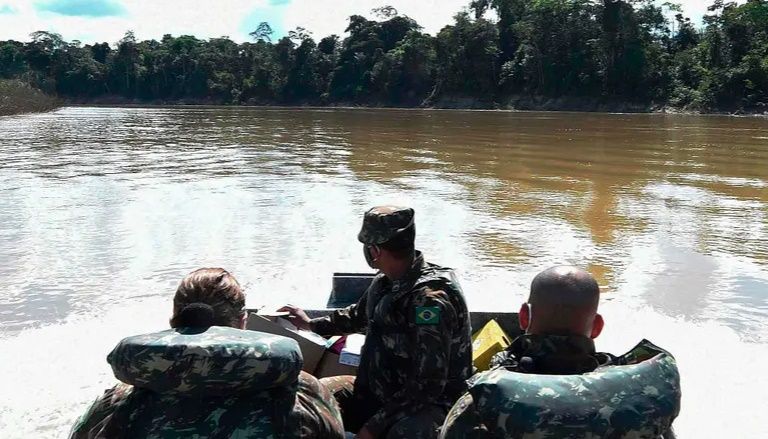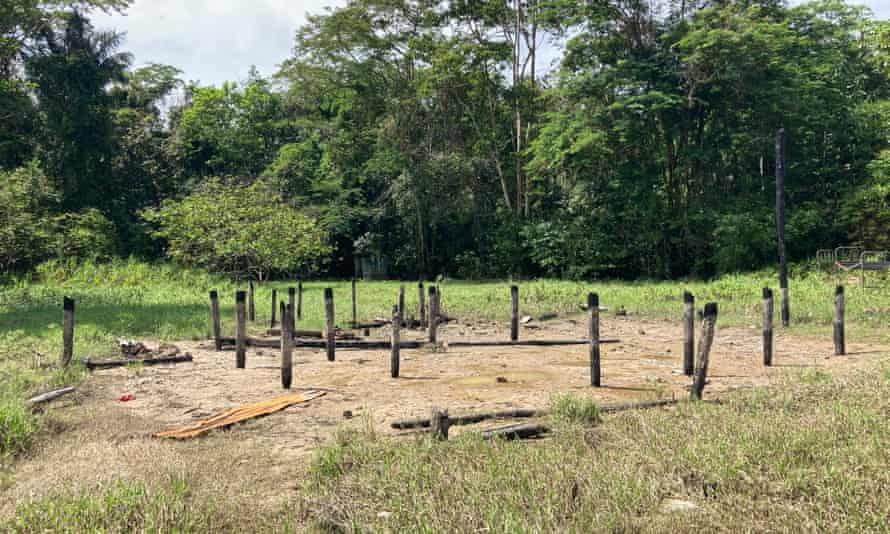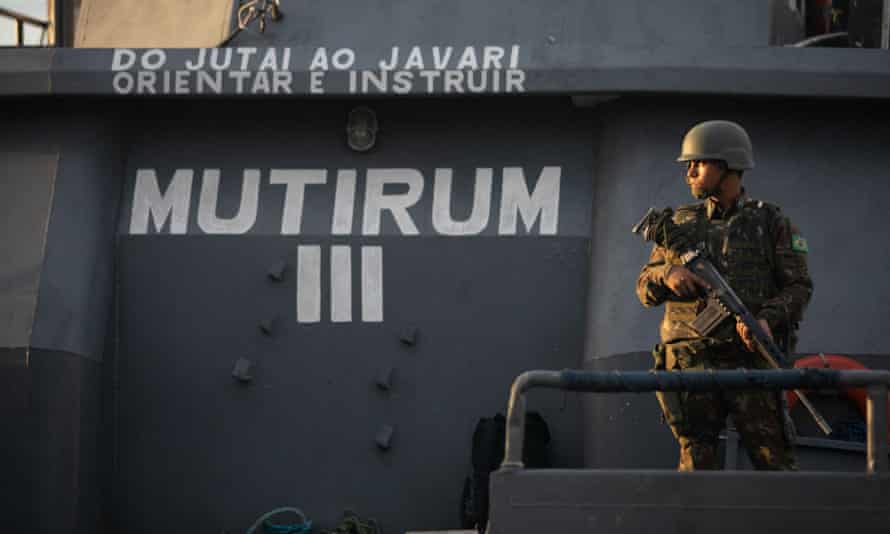Police losing narco war in deadly Amazon region where duo disappeared

The Guardian - by Tom Phillips in Puerto Amelia and Dan Collyns in Flor de Ucayali - Thu 16 Jun 2022 17.40 BST
A key police outpost lies in ruins after a daring raid – a sign of the growing danger on an increasingly lucrative smuggling route.
In the crime-infested tri-border region where Dom Phillips and Bruno Pereira disappeared, rumours abound over what happened at Puerto Amelia in January this year.
Were Brazilian drug traffickers responsible for burning the Peruvian police outpost on the River Yavarí to the ground?
Was it Colombian guerrillas who stormed the camp, shooting at the border guards and making off with their high-powered weapons?
Or were the culprits rogue Peruvian police officers, perhaps working for organized crime?
The answer depends on who you talk to – but the consequences were the same.
Five months after the audacious raid, the camp lies in ruins. Charred logs are the only remnant of a turquoise lodging the Peruvian troops had called home.
Filing cabinets and metal bunk beds are scattered in the undergrowth while the ground is littered with empty cans of tuna fish and spam. Tiger orange butterflies dance around an abandoned border marker, bringing colour to an otherwise desolate scene.
“They took guns, rifles, bullets, the lot,” said one local, who gave the Guardian a tour of the strategically positioned base, located opposite the entrance to the River Itaquaí, where Phillips and Pereira are feared to have been murdered.

The locals said the security situation had been deteriorating since 2020 as Latin American drug cartels and factions fought for control of this increasingly lucrative smuggling route.
“This is what the region is like now,” they sighed as they surveyed the deserted police position past which boats packed with drugs can now travel undisturbed. “It didn’t use to be like this.”
But this is not the first such attack on the feeble law enforcement in the Amazon region where Peru meets Colombia and Brazil.
“The narcos are bolder, more aggressive; they have attacked three police posts in the last five years,” a Peruvian anti-narcotics officer said.
“The small [police] bases are too remote, too isolated, too exposed. You need bases with 200 to 300 men, not 10 or 20,” he said. He estimated that 120 tonnes of cocaine base paste were being smuggled across the porous frontier between Peru and Brazil every year.
“This is an area being controlled by organised crime, not by the Peruvian state,” he said. Despite occasional police and military raids, the crime wave has overwhelmed state authorities in all three countries.
“The Amazon is a cancer patient and we’re just giving it a pill for the pain,” he added grimly.
The surge of criminal activity is partly driven by the rapid expansion of plantations of coca – the raw material of cocaine – on the Peruvian side of the triple frontier. Cultivation of the plant in the area known as Bajo Amazonas nearly doubled between 2019 and 2020 from 2,531 to 4,247 hectares, according to the Peruvian Drugs Observatory.
Across Peru, coca cultivation grew by 41% between 2016 and 2020, according to official Peruvian figures – an increase from 439 sq km to 617 sq km. The White House Office of National Drug Control Policy (ONDCP) says coca field cultivation is higher, reaching 882 sq km (or 88,200 hectares) in 2020, equivalent to 810 tonnes of potential cocaine.
Peru is the world’s second-biggest producer of cocaine after Colombia, according to the UN, producing around 26% of global cocaine output. The last two years have been bumper harvests.
But the country has also been buffeted by other forces: Peru suffered the worlds worst recorded per capita death toll in the Covid pandemic and its devastating impact hit law enforcement and drove rocketing unemployment. The result is a bonanza for organised crime in the Amazon region which stretches across more than half the country.
For Indigenous communities, that has led to a rise in intimidation, violence and murder as drug gangs target their land to plant new coca crops. Covid restrictions made the remote region even more vulnerable by slowing state efforts to protect land and eradicate illegal coca cultivation.
“We are facing a well-structured organisation that protects drug trafficking and other illegal activities in the Amazon,” said Robert Guimaraes, 49, a longtime Indigenous leader in Ucayali, in Peru’s central Amazon.
“Unfortunately, the state does not have the capacity to intervene sufficiently, and above all to support the Indigenous peoples of Ucayali who are on the border [with Brazil],” he said in Flor de Ucayali, the Shipibo-Konibo Indigenous community where he was born.
“There are no police here to give security to the people,” he said, joining a clamour of Indigenous Amazonian leaders who say police and prosecutors are failing to follow up their warnings, and are allowing killers to operate with impunity.
Ricardo Soberón, executive director of Peru’s anti-drug agency Devida, told the Guardian that “international drug trafficking has been directed totally towards the Amazon” as a result of the pandemic.
It is no coincidence that in 2020, Peru’s environment ministry reported record Amazon deforestation. A staggering 2,032 sq km(785 sq miles), a figure almost four times the 548 sq km it lost in 2019.
Across the triple frontier border, Brazil’s Amazonas state has become the battleground for a bitter struggle between rival drug militias, the São Paulo-based First Capital Command and Rio de Janeiro-based Red Command. In the past two years, the balance has tipped in favour of the Red Command, according to security experts.

Gen Mauro Esposito, former coordinator of special border operations for Brazil’s federal police, said both Brazilian gangs now have cells operating in the cocaine-producing regions of Peru along the length of the two countries’ Amazon border, where small planes carrying drugs cargoes make daily flights.
Barbara Arisi, a Brazilian anthropologist of Vrije Universiteit in Amsterdam and specialist in the Indigenous peoples of the Javari Valley (as the Yavarí is known in Brazil), said illegal fishing and hunting were the principal criminal activities in the area where Phillips and Pereira disappeared.
But she worried that drug traffickers using the rivers, or even transporting shipments on foot through the remote region, could put isolated communities at risk, particularly from illnesses to which they have no immunity.
“They could cause whole populations to die and we wouldn’t know anything about it,” she said. First contact with the Matis people in the 1970s decimated two-thirds of their population, she noted.
“The Indigenous [in the Javari Valley] people have a tragic past,” she told the Guardian.
“Now they are fighting because their friends have been killed. They are showing their faces, they are brave enough to protest in the face of organised crime,” she added.
Commentary:
Why do newspapers send/pay journalists to enter such an area known to be very dangerous, to investigate the ravaging of the Amazonas area, so important to the world's protection of forest areas? It was supposed to be one of Dom Phillips’s last trips to the Amazon, the kicker for a book that would reveal all the lush complexity of the world’s largest rainforest. HMM!!
HUMAN SYNTHESIS
COPYRIGHTS
Copy & Paste the link above for Yandex translation to Norwegian.
WHO and WHAT is behind it all? : >
The bottom line is for the people to regain their original, moral principles, which have intentionally been watered out over the past generations by our press, TV, and other media owned by the Illuminati/Bilderberger Group, corrupting our morals by making misbehaviour acceptable to our society. Only in this way shall we conquer this oncoming wave of evil.
All articles contained in Human-Synthesis are freely available and collected from the Internet. The interpretation of the contents is left to the readers and does not necessarily represent the views of the Administrator. Disclaimer: The contents of this article are of the sole responsibility of the author(s). Human-Synthesis will not be responsible for any inaccurate or incorrect statement in this article. Human-Synthesis grants permission to cross-post original Human-Synthesis articles on community internet sites as long as the text & title are not modified.
HUMAN SYNTHESIS